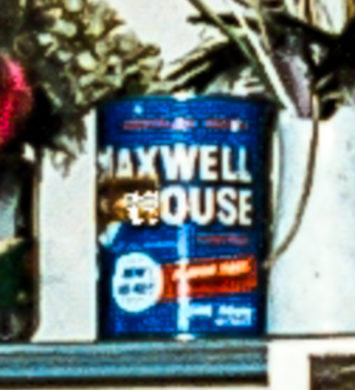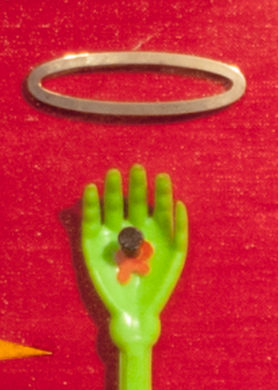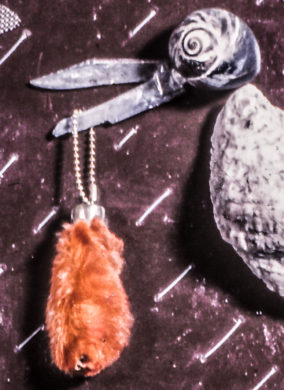A flagpole penis. A shrink’s couch in a pocket. A haloed spider. Did LSD lead Lou Hirshman to abandon caricaturizing the famous? Was his second period a psychedelic trip? Did he make high art or “high” art? In this FICTIONAL, TONGUE-IN-CHEEK story, Hirshman swims with dolphins to the other side of the other ocean.
Why Hirshman Drifted Past the Flowers
“Picture yourself in a boat on a river,
With tangerine trees and marmalade skies…”
From “Lucy in the Sky with Diamonds” on the Beatles 1967 Sgt. Pepper album

Dr. John C. Lilly was a renowned – and bizarre – scientist. Among his eclectic areas of research were sensory deprivation tanks, in which he took lysergic acid diethylamide – LSD – in an attempt to communicate with dolphins. Lilly even shared an LSD “acid” trip with a dosed dolphin so that both the fishy mammal and strange doctor could better “commune.”
Lilly also communed with the artist Lou Hirshman.
At the time of his initial dolphin experiments, Lilly was a neighbor of the artist, living on the same Philadelphia street, not far from the University of Pennsylvania where the scientist was conducting his unconventional research. Doctor and artist were well acquainted as Hirshman’s wife Betty was good friends with Lilly’s wife Mary. One evening following a dinner at the Hirshman home, Lilly asked to take coffee in the artist’s studio to view his latest creation. But while Lilly was admiring a witty, half-finished caricature on an easel in the corner, Hirshman sat down with a heavy sigh and started

sobbing. Looking at the easel, he told Lilly of his pain of being considered little more than a cartoonist, “a comical art hack of celebs,” rather than a

serious comedian of art.
Lilly just smiled at Hirshman. Saying nothing, from his pocket he took out two square tabs, dropping one in each of their coffees.
“What’s that?” asked the artist.
“My kind of art,” replied Lilly mysteriously with no mention of LSD. “As the dolphins say, ‘It is time to swim on a trip to the other side of the other ocean.'”
They drank and communed.

Timothy Leary, the LSD guru, who befriended Lilly in later years, once wrote in a now out-of-print essay how the researcher influenced the caricaturist to experiment with psychedelics. “LSD shines a light from ‘within’ a tripper’s own world,” Leary noted. “Lilly showed Hirshman how to shine that light from ‘without’ through the world of his mind.”

Lilly’s psychedelia changed Hirshman’s life, recalled the artist’s colleague Mack Gottfried in a magazine interview. “Lou didn’t want to be simply typecast as a maker of what he called ‘facsimiles of the famous with three-dimensional junk,’” Gottfried said. “That’s when he started his collage period, still grounded in wit, but doing work that would soon soar as high art.”
And “high” that art proved to be.
The altered state of his work was mind-blowing. For the rest of Hirshman’s life until his death in 1986, his body of work was almost an out-of-body experience, as the artist watched himself watching an artist of insight swim to the other side of the other ocean. Some refer to it as his “High Period.” Lilly, however, would always call it Hirshman’s “Dolphin Period.”
So, whether sober or not, we invite you to swim with the dolphins – to tune in, turn on, and drop out – for a magical mystery tour as you float downstream through Hirshman’s psychedelic world of art.
The Trip – 1967

This unambiguously psychedelic-infused piece is reminiscent of the 1932 “melting watch” painting by Salvador “I-don’t-do-drugs, I-am-drugs” Dali. Simply put, it is an unabashed ode to Hirshman’s drug of choice – LSD. This desert-landscaped collage includes:
by Salvador “I-don’t-do-drugs, I-am-drugs” Dali. Simply put, it is an unabashed ode to Hirshman’s drug of choice – LSD. This desert-landscaped collage includes:
● a cool, hip and druggy sun sporting sunglasses,
● a small baby doll stilt-walking on hairpin legs, while dragging a pearl ball and chain,
● a green plastic backscratcher with a slightly bloodied palm hammered into the backboard and crowned with a halo, an unmistakable ribbing of Jesus on a Christian cross by a Jewish artist 
● a zonked-out, wandering roach, a slogan on its back advertising “EAT AT JOE’S,” a reference to a diner frequented by Hirshman where he sometimes had a “cup of joe” with an acid-spiked sugar cube. 

The piece was finished in the 1967 Summer of Love. John Lilly told a movie director acquaintance about it, who, inspired by the title, quickly changed a psychedelic movie he was about to release from “The Tour” to “The Trip.” The hallucinogenic film was written for the screen by the then-counterculture actor Jack Nicholson, who, according to an anonymous gallery owner, unsuccessfully bid on Hirshman’s “The Trip.” It also affected the Beatles. Fearing a copyright suit, they changed the name of their upcomingc album from “Sgt. Peppers Lonely Hearts Club Trip” to “Sgt. Peppers Lonely Hearts Club Band.”
Landscape – 1982

Hirshman’s “Landscape” is really a “drug-scape,” filled with dreamy – and sometimes nightmarish – LSD-drenched images hidden in the details:
 ● on the river is a water-skier pulled by a fish, a tip-of-the-hat homage to Dr. Lilly and his
● on the river is a water-skier pulled by a fish, a tip-of-the-hat homage to Dr. Lilly and his  trippy dolphin comm
trippy dolphin comm unication research.
unication research.
● a flagpole with a roach waving an “EAT AT JOE’S” flag on a pole which looks suspiciously like the head and shaft of an erect penis covered with a condom.
● a steepled town hall, with jails bars at the base, being climbed by a pair of monster-sized roaches (the upper one with a hard-to-see cross on its back) toward the spire topped by a  pirouetting ballerina.
pirouetting ballerina.
● a stork flying toward the steeple carrying a newborn boy, complete with penis.
Due to the collage’s “druggy” elements, the Philadelphia Museum of Art refused to acquire the piece after Hirshman’s death, opting instead for the artist’s 1940 caricature of Albert Einstein.
The City – 1966
The metropolis of the title is Hirshman’s hometown of Philadelphia, where the city’s Quaker founder,  William Penn, is given idol status as a very strange outsized statue perched high atop City Hall. This
William Penn, is given idol status as a very strange outsized statue perched high atop City Hall. This

tourist attraction, complete with an observation deck, was made all the more surreal in this Hirshman artwork:
● the William Penn statue replaced with a miniature baby doll in one-footed balance on a baby bottle while holding a safety pin (in the actual statue of William Penn, he is holding a scroll of a treaty, which from one vantage point appears to be a penis peeing on the city).
● a billboard-like, pill-filled “aspirin” box, topped by a die with four dots (a dot is a slang term for LSD, representing Hirshman’s hallucinatory search for the fourth dimensional continuum of space and time.)
● a skyscraper constructed with the filmstrip of a MOVIETONE Newsreel (a popular pre-feature offering in mid-20th Century movie theaters), flipped vertically with an  inverted text reading: “Mike Todd
inverted text reading: “Mike Todd  Plunged to Meteoric Death Wreckage Reveals.” Todd was a movie producer, married to actress Elizabeth Taylor, who died in a 1958 airplane crash, thus literally having experienced a “bad trip.”
Plunged to Meteoric Death Wreckage Reveals.” Todd was a movie producer, married to actress Elizabeth Taylor, who died in a 1958 airplane crash, thus literally having experienced a “bad trip.”
The Psychiatrist – 1965

One of Hirshman’s first non-celebrity caricatures using found objects, this collage is born of a Hirshman “trip” gone awry. It shows a psychedelic psychiatrist seemingly treating himself with LSD. The analyst’s visage exudes distressing Freudian symbols:
 ● handcuff glasses
● handcuff glasses
● worming wrinkles
● a bird-brained mustache and goatee
● a suit jacket of all-seeing eyes.
● in the eerie doctor’s handkerchief pocket is a tiny psychiatrist’s couch.
According to old calendars discovered in Hirshman’s studio after his death, his life was crammed with ample opportunities to lie on a shrink’s sofa during his weekly visits to a Philadelphia psychiatrist, where he presumably shared many of his LSD revelations.
Better Stop Drinking – 1969
 Originally titled “Better Stop Dropping,” Hirshman changed the name to hide the source of his artistic inspiration. This acid-y artwork shows:
Originally titled “Better Stop Dropping,” Hirshman changed the name to hide the source of his artistic inspiration. This acid-y artwork shows:
● a goat-like animal surreally depicted with a bone and doorbell-buzzer snout
● matchstick teats on the animal,  indicating a female. Hirshman chose the theme, based on a 1964 study on the ambulatory effects of LSD when given to female goats
indicating a female. Hirshman chose the theme, based on a 1964 study on the ambulatory effects of LSD when given to female goats
 ● a haloed spider-like insect in the lower right-hand corner hanging from a red thread. The arachnid was likely added later, according to Hirshman’s son, when the artist learned of a study that examined how giving LSD to spiders disrupts the webs they spin. This inspired Hirshman to add a background of geometric, spidery lines that were straight rather than in concentric near-circle patterns.
● a haloed spider-like insect in the lower right-hand corner hanging from a red thread. The arachnid was likely added later, according to Hirshman’s son, when the artist learned of a study that examined how giving LSD to spiders disrupts the webs they spin. This inspired Hirshman to add a background of geometric, spidery lines that were straight rather than in concentric near-circle patterns.
The Flood – 1964
 Although the LSD symbolism is difficult to recognize, “The Flood” is sometimes cited
Although the LSD symbolism is difficult to recognize, “The Flood” is sometimes cited  as Hirshman’s earliest piece relating to a hallucinatory trip. In the collage, a bird has taken refuge on a house swept away by a rainy deluge of biblical proportions. There are two Hirshman choices of material that point toward an LSD influence:
as Hirshman’s earliest piece relating to a hallucinatory trip. In the collage, a bird has taken refuge on a house swept away by a rainy deluge of biblical proportions. There are two Hirshman choices of material that point toward an LSD influence:
● a comic strip man trapped at the base of house, who, close to drowning, shouts “H-E-L-P” (in writing) with the dropped “h” indicating a British character.
● a bird carries a lucky rabbit’s foot, hanging from its beak.
Some literary scholars consider this second LSD clue a reference to Hirshman’s favored author, Lewis Carroll, whose innocent girl-character Alice of “Wonderland” fame takes a hallucinatory “trip” by following a talking white rabbit down a hole. Hirshman’s allusion to Carroll’s drug-saturated tale predates – and possibly influenced – a similar theme in the 1967 counterculture, trippy song “White Rabbit” by Grace Slick of the Jefferson Airplane.
More on LSD and LOU
Hirshman’s LSD “visions” have taken a trip through many of his works (click on the titles to see several of those pieces):
● Still Life #2 – 1967: Baby’s golden arm rising from a vase
● On the Veldt – 1967: An animal kingdom of freaky wildlife
● The Hangover – 1969: a crocodile exiting the sufferer’s mouth
● Mutation – 1969: Entire piece
● Totem – 1969: Lapel button that reads: “Ymdrechwn yn galtach,” Welsh for “We try harder,” the 1960s Avis car rental slogan
● Pot Smoker in Orbit – 1970: Zero-gravity stoner
● Bird #1 – 1969: Fowl on a fishbone
● Triumph of Death – 1974: Simply a bad trip
● Ballet of the Sun – 1980: Zipper man holding the sun
● Leda – 1982: Another baby arm
The LSD influence can be found throughout Hirshman’s catalog in his Dolphin period. Even at his death, on his easel in  his home studio was a nearly finished piece showing two clownish characters not yet with
his home studio was a nearly finished piece showing two clownish characters not yet with mouths or noses (or was this lack of features another LSD vision?). The psychedelic details are mostly on the right-hand character:
mouths or noses (or was this lack of features another LSD vision?). The psychedelic details are mostly on the right-hand character:
● a hooked fish hanging from a pretzel ear
● the playing cards containing two pairs – kings and aces
● No hearts on any of the cards except for the upper-most card, an ace of diamonds with hearts added above and  below the single diamond
below the single diamond
Together all of Hirshman’s artwork in his collage period, inspired by Lilly and LSD, reveal an artist who simply dropped out. He forsook a career path to almost-certain fame as a one-of-a-kind caricaturist, opting instead for a path through his own mind filled with LSD images. Hirshman, once lost in commercialism, found a home – a home next to a Lucy-in-the-Sky river, where “Everyone smiles as you drift past the flowers, That grow so incredibly high.”
William P. Hirshman

Author’s note: Except for the artwork presented and Dr. Lilly – who indeed did live on Hirshman’s street until his divorce in 1959 and was an LSD advocate (although it is questionable whether he actually took the drug before 1964) – this post is pure fiction. Hirshman was a teetotaler, who was never seen inebriated. The artist certainly never took drugs. His choice of images, motifs and materials were not the result of LSD trips, but rather “trips” taken through his mind while practicing yoga daily and during his workaday five-mile walks to the art school where he was the faculty director.
So for those who think of Hirshman as a comical caricaturist of the famous. it may be time to take a closer look at this artist who created a psychedelic world of his own.
Disclaimer: hirshman-art.com does not condone the use of any mind-altering drugs.




